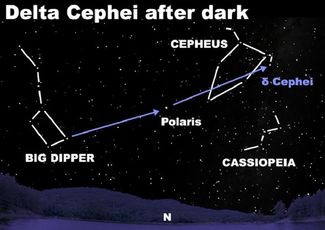Seeing a Cosmic Yardstick
Last updated 7/22/2016 at 10:12am
I have a friend who swears that he can tell the distances to the stars just by looking at them, but he's never convincingly demonstrated to me his amazing powers. The reason is that it just isn't possible.
Oh, sure, anyone could do it if all stars were alike. Then, if star A appeared four times dimmer than star B, it would have to be two times farther away; if it appeared nine times fainter it would be three times farther, and so on. But stars are not alike, and therein lies the rub. Each star pumps out vastly different amounts of radiation and we can't assume that a star is farther just because it appears fainter. Actually, the opposite is often true: the brightest-appearing stars are often farthest away. This occurs because stars radiating the least can be seen only if they're nearby; those that are most luminous are much less common, but we can see them at greater distances. So it's just not possible to judge star distances based simply on how bright they are.
One way we can measure stellar distances is by triangulation, a technique we all learned in elementary school. Hold your thumb out at arm's length and alternately blink your eyes. Your thumb will appear to shift its position relative to background objects and, since your brain knows how far apart your eyes are, it can estimate how distant your thumb must be. We can do the same with stars -- not by blinking our eyes, of course, but by measuring a star's exact position at six month intervals, when the Earth lies on opposite sides of its orbit around the sun. If the star appears to shift its position between these two times, we can calculate how far it must be.
Unfortunately, this works only for the nearest of stars. To learn stellar distances across more of the cosmos, astronomers must be clever. And, indeed, they are. They've found an entire class of stars that serves as an accurate "cosmic yardstick". The first of these stars to be discovered is known as Delta Cephei, and we can find it easily with the naked eye in the constellation Cepheus, the king, in the northeastern sky after dark this week. This star oscillates in size and temperature, and appears to brighten and fade in our sky every 5.3 days.
Not until 1912 did Harvard College astronomer Henrietta Leavitt notice that the average brightness of such "Cepheid" was related to their periods of pulsation. From this, astronomers soon developed a "Period-Luminosity" law, which states that the longer it takes a Cepheid to undergo one cycle, the more intrinsically luminous the star must be. Armed with this new law, astronomers can measure the period of a Cepheid anywhere in our galaxy -- or beyond -- and can easily infer its actual luminosity. And, by comparing how bright it appears with the light it's actually emitting, they can calculate its distance. In this way, Cepheid variable stars have become one of astronomers' most valuable "cosmic yardsticks", and help them to measure the size of the entire universe.
And there's one right over your rooftop after dark tonight.




